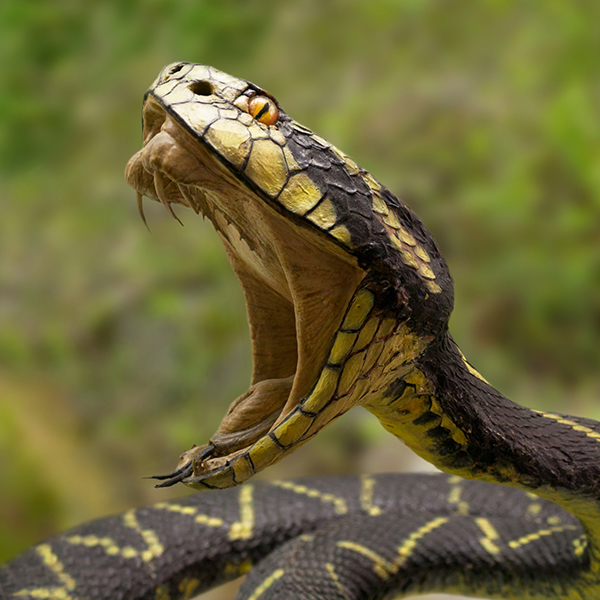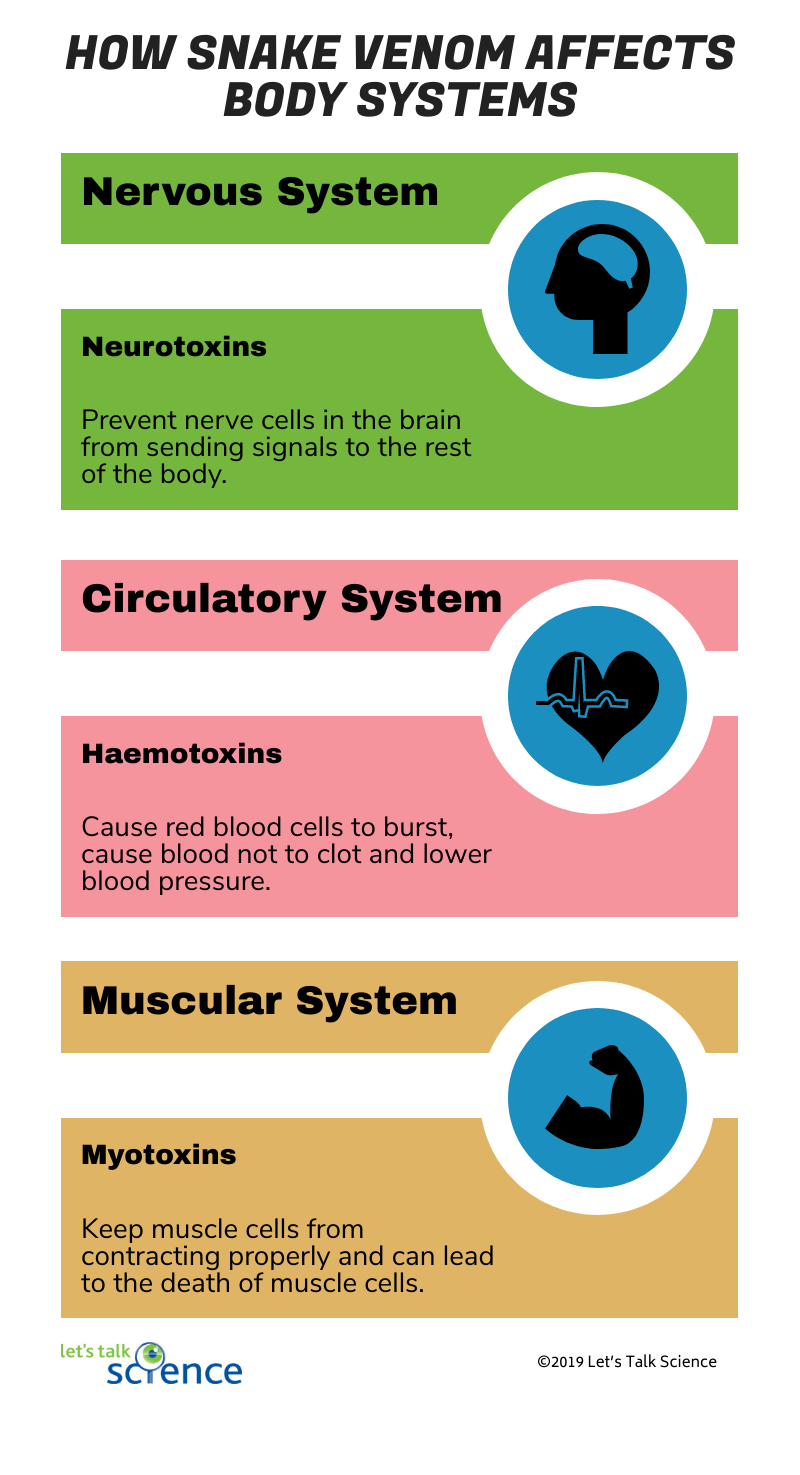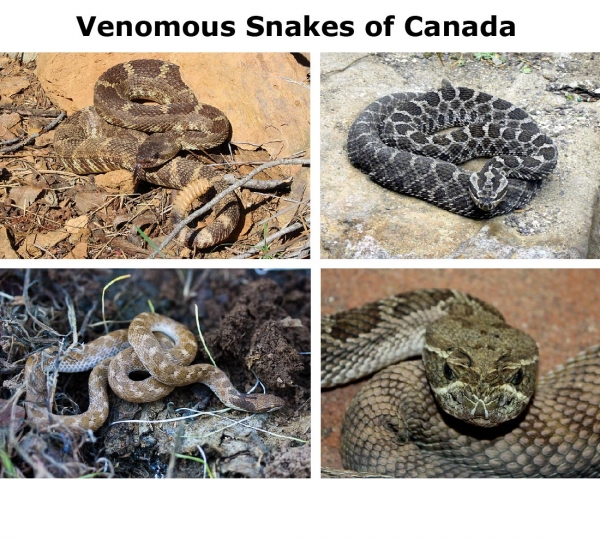How Snake Venom Kills… and Saves Lives

Snake with open mouth (OldGreyMan, iStockphoto)

Snake with open mouth (OldGreyMan, iStockphoto)
How does this align with my curriculum?
| Grade | Course | Topic |
|---|
Snake venom can be dangerous for your circulatory system, nervous system or muscular system. But it can also be very useful in medicine.
Are you afraid of snakes? Of the 3 000 species of snakes, only around 450 are poisonous and potentially dangerous to humans. These kill around 100 000 people a year - mostly in Asia, Africa and Latin America. But their venom has also been used in medical discoveries that can save human lives.
Did you know?
Poison refers to toxins that are ingested, inhaled, or absorbed by touch, such as from the skin of a poison dart frog. Venom refers to toxins injected into the body, such as by a snake’s fangs.
How does venom work?
Snake venom is produced in the back of the snake's head in the salivary glands. Salivary glands are the parts of the head where saliva is made. To deliver venom, snakes have hollow fangs that act like hypodermic needles. When a snake bites, muscles in its head squeeze the venom glands. This pushes the liquid through its fangs muscles in its head squeeze the venom glands. This pushes the liquid through its fangs and into the flesh of its prey.
What is in snake venom? It varies from one species to the next. Sometimes, snakes of the same species that live in different locations can have slightly different venom compositions.
Once the toxins are injected, they can work in several ways depending on the type of snake. Some toxins target the nervous system. These are called neurotoxins. Neurotoxins prevent neurons in the brain from transmitting signals. This causes paralysis. Other toxins harm the circulatory system. These are called haemotoxins. Haemotoxins can cause red blood cells to burst, cause blood to clot, or severely lower blood pressure. Others toxins harm the muscular system. These are called myotoxins. Myotoxins cause tissue death in muscles and prevent muscle contraction. Another word for tissue death is necrosis.
Snake bite poisonings are called envenomings.

Did you know?
The longest venomous snake in the world is the king cobra. It can grow to over 4 metres long! It rarely bites, and its venom is not as toxic as that of most other cobras.
How do you treat snake bites in humans?
Every year there are about 5.4 million snake bites. This leads to between 1.8 to 2.7 million envenomings. There are between 81 410 and 137 880 deaths. There are even more amputations and other permanent disabilities as a result. People die from snake bites most often in Asia and Africa. These places have lots of venomous snake species. They also have lots of agricultural workers who come into contact with snakes. And often, the closest hospital might be far away.
Medical researchers have developed antivenoms. Antivenoms contain antibodies that attack the dangerous proteins in venom. To develop an antivenom, a host animal is injected with larger and larger amounts of venom. Usually, this animal is a horse. Eventually, the horse’s immune system causes blood plasma cells to produce antibodies. The antibodies are then extracted from the host animal’s body, processed, and purified so they can be given to snakebite victims.
Different kinds of antivenom are usually specific to a single snake species or a group of related species. They can also be very expensive. For example, in the United States, patients can be charged thousands or even tens of thousands of dollars for a single vial! Most snake bites need to be treated with multiple vials.

Is snake venom ever helpful?
Although the toxins in snake venom can hurt humans, they can also be used as medicine. For example, some snake venom affects blood pressure and blood clotting. Scientists can use this snake venom to develop new drugs to treat illnesses. In fact, the proteins in snake venom has been used to treat many conditions. Some examples are cancer, pain, high blood pressure, heart attacks, strokes, Alzheimer's disease, and Parkinson’s disease. The venom of other animals, such as spiders and scorpions, has also been used to develop important drug treatments.
How do scientists develop drugs from snake venom?
Developing new drugs from snake venom takes a lot of time, effort and money. First, the different ingredients inside snake venom are separated. This allows scientists to test and identify those with useful medical applications. For example, some ingredients might have the ability to block pain. Next, scientists try to develop a synthetic (not natural) version of the compound. They then test the compound in small doses on animals. Finally, scientists create a version of the drug for humans. They test it and make sure it’s safe. Once they are sure, they put it on the market.
Snake venom is a very powerful tool for snakes to subdue their prey, but also for doctors to treat illnesses and snake bites. The development of new antivenoms will hopefully decrease the number of people who die from snake bites. And the discovery of next-generation drugs to combat heart attacks, strokes, and even cancer may rely on hidden secrets contained in snake venom.
Starting Points
- What is your opinion of snakes? What characteristics of snakes do you particularly like or dislike?
- Have you ever had any experiences with venomous snakes? If so, explain.
- How has your opinion of venomous snakes changed by learning that products from snake venom have a practical use in human medicine?
- Have you ever had a flu vaccine? How does a vaccine work in your body to prevent the flu?
- Why are synthetic venoms developed for research and development? Why not use natural venom?
- Should greater efforts be made to preserve venomous snake species due to their potential medical value? Why or why not?
- Why is the production of venom a useful adaptation for certain species of snakes?
- What is antivenom? How does it work against a venomous snake bite? Why does one type of antivenom not work on all snake bites?
- Why is a host animal required to produce antivenom? Why are horses given increasingly larger doses of snake venom for producing antibodies?
- Conduct online research to determine where in world antivenom is produced. Why is antivenom produced in these areas?
- Why do scientists continue looking to nature for potential sources of new medicines and antibiotics?
- Why are animals invaluable to scientific research efforts? What alternatives exist to using live animals for research purposes? (Note: this question will require additional research)
- Snakes are often used as characters in popular media (novels, comics, movies). What snakes can you think of from stories or movies? What personality characteristics and stereotypes do we associate with snakes? Do you think these characterizations influence our feeling towards real snakes? How so?
- What sayings or quotes about snakes are you familiar with? (e.g., She is lower than a snake’s belly) What characteristic of snakes does the saying refer to? Does it paint a positive or negative image of snakes?
- This article can be used to support teaching and learning in Biology, Human Health & Wellness and the Nature of Science. In discussing the effects of snake venom on the human body and the application and production of antivenom, the article includes concepts such as venom, antivenom, immune system, host and antibodies.
- Before reading the article, students could use a Vocabulary Preview learning strategy to access prior knowledge and introduce new terms. Ready-to-use Vocabulary Preview reproducibles are available in [Google doc] and [PDF] formats.
- After reading the article, teachers could have students summarize their understanding of venom and antivenom by creating a graphic organizer that compares and contrasts the facts about each of these products.
Connecting and Relating
- What is your opinion of snakes? What characteristics of snakes do you particularly like or dislike?
- Have you ever had any experiences with venomous snakes? If so, explain.
- How has your opinion of venomous snakes changed by learning that products from snake venom have a practical use in human medicine?
- Have you ever had a flu vaccine? How does a vaccine work in your body to prevent the flu?
Relating Science and Technology to Society and the Environment
- Why are synthetic venoms developed for research and development? Why not use natural venom?
- Should greater efforts be made to preserve venomous snake species due to their potential medical value? Why or why not?
Exploring Concepts
- Why is the production of venom a useful adaptation for certain species of snakes?
- What is antivenom? How does it work against a venomous snake bite? Why does one type of antivenom not work on all snake bites?
- Why is a host animal required to produce antivenom? Why are horses given increasingly larger doses of snake venom for producing antibodies?
- Conduct online research to determine where in world antivenom is produced. Why is antivenom produced in these areas?
Nature of Science/Nature of Technology
- Why do scientists continue looking to nature for potential sources of new medicines and antibiotics?
- Why are animals invaluable to scientific research efforts? What alternatives exist to using live animals for research purposes? (Note: this question will require additional research)
Media Literacy
- Snakes are often used as characters in popular media (novels, comics, movies). What snakes can you think of from stories or movies? What personality characteristics and stereotypes do we associate with snakes? Do you think these characterizations influence our feeling towards real snakes? How so?
- What sayings or quotes about snakes are you familiar with? (e.g., She is lower than a snake’s belly) What characteristic of snakes does the saying refer to? Does it paint a positive or negative image of snakes?
Teaching Suggestions
- This article can be used to support teaching and learning in Biology, Human Health & Wellness and the Nature of Science. In discussing the effects of snake venom on the human body and the application and production of antivenom, the article includes concepts such as venom, antivenom, immune system, host and antibodies.
- Before reading the article, students could use a Vocabulary Preview learning strategy to access prior knowledge and introduce new terms. Ready-to-use Vocabulary Preview reproducibles are available in [Google doc] and [PDF] formats.
- After reading the article, teachers could have students summarize their understanding of venom and antivenom by creating a graphic organizer that compares and contrasts the facts about each of these products.
Learn more
Snakes of Canada (2008)
Information on snakes from the Canadian Wildlife Federation, where to find them, and how to protect them (most are harmless!)
Venomous Cures (2008)
More information from PBS Nature on some of the diseases venoms can cure and links to plenty of other reptile info.
Snakebite Envenoming (2019)
Fact sheet from the World Health Organization about the number of people around the world who are hurt and killed by snakes and what is being done to help.
References
Bailey, R. (2018, April 16). How does snake venom work? ThoughtCo.
Planet Earth Online. (2012, October 15). Snake venom discovery could aid drug development. EarthSky.
Puiu, T. (2019, February 15). Antivenom: How it’s made and why it’s so precious. ZME Science.
World Health Organization. (n.d.). Snakebite envenoming: Treatment.